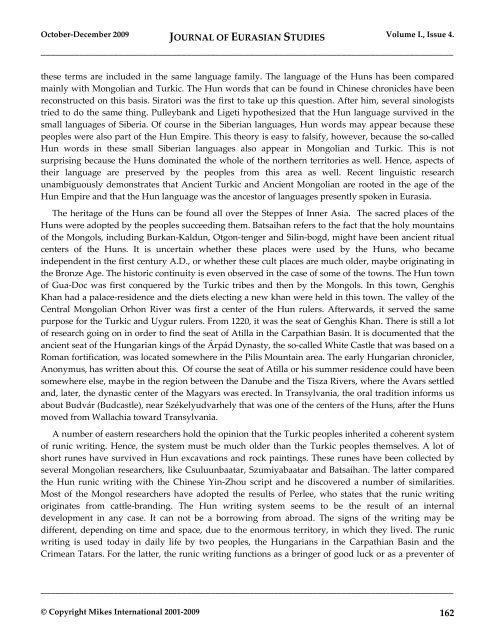JOURNAL OF EURASIAN STUDIES
JOURNAL OF EURASIAN STUDIES
JOURNAL OF EURASIAN STUDIES
Create successful ePaper yourself
Turn your PDF publications into a flip-book with our unique Google optimized e-Paper software.
October-December 2009 <strong>JOURNAL</strong> <strong>OF</strong> <strong>EURASIAN</strong> <strong>STUDIES</strong> Volume I., Issue 4.<br />
_____________________________________________________________________________________<br />
these terms are included in the same language family. The language of the Huns has been compared<br />
mainly with Mongolian and Turkic. The Hun words that can be found in Chinese chronicles have been<br />
reconstructed on this basis. Siratori was the first to take up this question. After him, several sinologists<br />
tried to do the same thing. Pulleybank and Ligeti hypothesized that the Hun language survived in the<br />
small languages of Siberia. Of course in the Siberian languages, Hun words may appear because these<br />
peoples were also part of the Hun Empire. This theory is easy to falsify, however, because the so-called<br />
Hun words in these small Siberian languages also appear in Mongolian and Turkic. This is not<br />
surprising because the Huns dominated the whole of the northern territories as well. Hence, aspects of<br />
their language are preserved by the peoples from this area as well. Recent linguistic research<br />
unambiguously demonstrates that Ancient Turkic and Ancient Mongolian are rooted in the age of the<br />
Hun Empire and that the Hun language was the ancestor of languages presently spoken in Eurasia.<br />
The heritage of the Huns can be found all over the Steppes of Inner Asia. The sacred places of the<br />
Huns were adopted by the peoples succeeding them. Batsaihan refers to the fact that the holy mountains<br />
of the Mongols, including Burkan-Kaldun, Otgon-tenger and Silin-bogd, might have been ancient ritual<br />
centers of the Huns. It is uncertain whether these places were used by the Huns, who became<br />
independent in the first century A.D., or whether these cult places are much older, maybe originating in<br />
the Bronze Age. The historic continuity is even observed in the case of some of the towns. The Hun town<br />
of Gua-Doc was first conquered by the Turkic tribes and then by the Mongols. In this town, Genghis<br />
Khan had a palace-residence and the diets electing a new khan were held in this town. The valley of the<br />
Central Mongolian Orhon River was first a center of the Hun rulers. Afterwards, it served the same<br />
purpose for the Turkic and Uygur rulers. From 1220, it was the seat of Genghis Khan. There is still a lot<br />
of research going on in order to find the seat of Atilla in the Carpathian Basin. It is documented that the<br />
ancient seat of the Hungarian kings of the Árpád Dynasty, the so-called White Castle that was based on a<br />
Roman fortification, was located somewhere in the Pilis Mountain area. The early Hungarian chronicler,<br />
Anonymus, has written about this. Of course the seat of Atilla or his summer residence could have been<br />
somewhere else, maybe in the region between the Danube and the Tisza Rivers, where the Avars settled<br />
and, later, the dynastic center of the Magyars was erected. In Transylvania, the oral tradition informs us<br />
about Budvár (Budcastle), near Székelyudvarhely that was one of the centers of the Huns, after the Huns<br />
moved from Wallachia toward Transylvania.<br />
A number of eastern researchers hold the opinion that the Turkic peoples inherited a coherent system<br />
of runic writing. Hence, the system must be much older than the Turkic peoples themselves. A lot of<br />
short runes have survived in Hun excavations and rock paintings. These runes have been collected by<br />
several Mongolian researchers, like Csuluunbaatar, Szumiyabaatar and Batsaihan. The latter compared<br />
the Hun runic writing with the Chinese Yin-Zhou script and he discovered a number of similarities.<br />
Most of the Mongol researchers have adopted the results of Perlee, who states that the runic writing<br />
originates from cattle-branding. The Hun writing system seems to be the result of an internal<br />
development in any case. It can not be a borrowing from abroad. The signs of the writing may be<br />
different, depending on time and space, due to the enormous territory, in which they lived. The runic<br />
writing is used today in daily life by two peoples, the Hungarians in the Carpathian Basin and the<br />
Crimean Tatars. For the latter, the runic writing functions as a bringer of good luck or as a preventer of<br />
_____________________________________________________________________________________<br />
© Copyright Mikes International 2001-2009 162
















